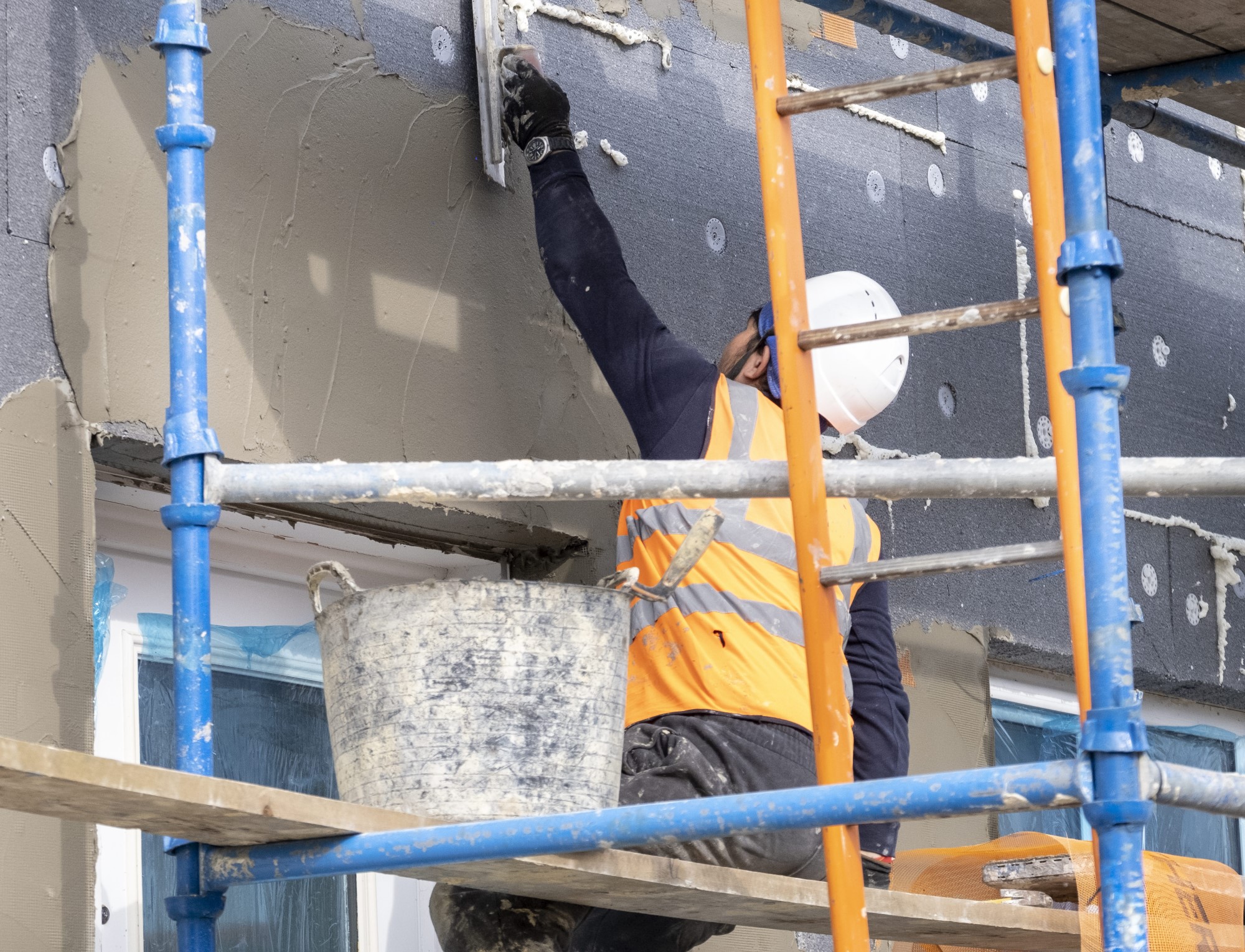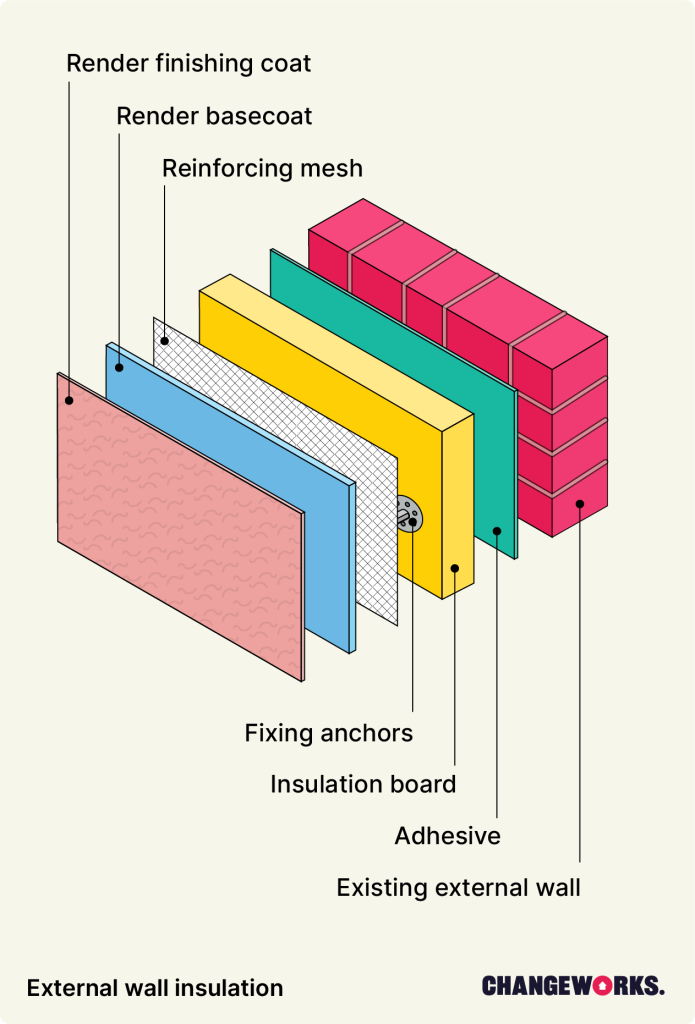External Wall Insulation
Installing external wall insulation is like putting a winter coat on your home. An installer applies a layer of insulation material to the outer walls, then covers this with render or cladding.

What is external wall insulation?
External wall insulation reduces heat loss through solid (non-cavity) walls. An installer applies a layer of insulation material to the outer walls, then covers this with render or cladding.
Because it’s installed on the outside of a home, you might also hear EWI referred to as “outside wall insulation”. Adding this extra layer of insulation means that less warmth escapes through the walls. As well as keeping the heat inside your home, you’ll also be better protected against rain and bad weather.
What’s more, external wall insulation also has the added bonus of a fresh new look for your property. There are lots of different options when it comes to the type of finish you want.

How does external wall insulation work?
Installers apply external wall insulation in layers. It’s like making a sandwich, where the bottom slice of bread is your exterior wall.
The insulation layer keeps the heat inside your home. Each layer has different options, with variations in both cost and performance.
The insulation boards make up the layer that actually keeps the heat in. They’re made from an insulating material such as mineral wool or expanded polystyrene. The installer applies insulation boards directly to the exterior wall.
External wall insulation fixings keep the insulation securely in place. The boards are usually “mechanically fixed” to the wall. This means they’re secured in place with screws or bolts. Adhesive may also be used.
External wall insulation finishes are the final layer of external wall insulation. They protect the insulation beneath and increase the weatherproofing of your home. Additionally, they give the wall an aesthetically pleasing finish.
There are two types of finish: wet render and dry cladding.
Wet render is a lot like plastering over an internal wall. The installer applies a sand and cement mix over a wire mesh. Alternatively, they may use a lime-based render instead of sand and cement. You can pebble-dash over wet render to create an attractive finish.
Dry cladding involves adding a finishing layer of boards, panels or tiles. Dry cladding tends to be more expensive than wet rendering, but there are a wider range of materials and designs on offer.
Pros and cons of external wall insulation
- Can save you money on your heating bills
- Refreshes your home’s appearance
- Reduces condensation on internal walls
- No changes or disruption to the inside of the house
- Better protection against wind and rain
- Relatively expensive: a typical three-bed semi-detached house will cost around £12,000 to insulate
- Can cause issues with damp if installed incorrectly
- May require planning permission
- Scaffolding is needed for installation
Is external wall insulation right for my home?
When making any changes to home insulation, it’s important to take a whole house approach. This means looking at how the insulation will affect different aspects of the building, especially how air and moisture circulate.
A good installer will help you decide on the best type of external wall insulation for your home. They will work out an option which keeps your home warm whilst avoiding problems with damp and condensation.
It’s also a good idea to consider the second option for insulating solid walls: internal wall insulation. Our guide to internal wall insulation will help you decide if you’d prefer this method of improving your walls’ thermal performance.
External wall insulation cost and funding
External wall insulation cost
The cost of external wall insulation will depend on the size of your property. For example, a three-bed semi-detached house typically costs £12,000 to insulate.
To reduce the cost, many people decide to have external wall insulation carried out at the same time as other work to their property.
External wall insulation grants can help with the cost of installation. See the section below for more details.
External wall insulation grants
Home Energy Scotland offer £7,500 of grant funding for homeowners in Scotland looking to install external wall insulation. In addition, £2,500 is available as an interest-free loan.
To apply for an external wall insulation grant, call Home Energy Scotland’s freephone number on 0808 808 2282. One of the advisors will be able to take you through the process.
External wall insulation is sometimes offered through Scottish government funded projects. If you are eligible for an Energy Efficient Scotland: Area Based Scheme, your local council or their managing agent should get in touch with you.
External wall insulation FAQs
Installers will only need access to the outside of your property – they shouldn’t need to come inside.
External wall insulation requires scaffolding. As a result, if you have a garden, you’ll need to move any obstacles (like furniture) out of the way.
The time it takes can vary significantly. On the one hand, private installs may be as quick as two weeks. On the other hand, installs through a funded project can take considerably longer. Furthermore, weather and temperature will affect the time the install takes.
Depending on the type of render you choose, there may be extra disruption. For example, stone chips often end up on the ground/in the garden during the rendering stage (when the installer adds the final layer to the wall).
The installer should clean these up at the end of the install, as well as taking measures to protect your doors and windows during the rendering stage.
Yes, in most cases. The best option is to have the whole block insulated, because this will give the block a consistent look.
Depending on your tenure (the type of ownership you have, or the type of lease you have) you may require permission for the work.
It may be possible to just insulate the wall outside your flat, but not all installers will offer this. If in doubt, it’s best to consult a few different installers.
A list of accredited installers can be found on the National Insulation Association’s website.
If you live in a listed building and/or a conservation area, you’ll need to get consent from your Local Planning Authority. This might mean getting Listed Building Consent, Planning Permission, or both.
You can find out which permissions you need using this tool on the Scottish Government’s ePlanning website.
If you’re not sure whether you live in a conservation area or listed building, you can find out on your local authority’s website.

Changeworks delivers Home Energy Scotland in the south east and Highlands and Islands on behalf of the Scottish Government and Energy Saving Trust.
As well as providing free, impartial expert advice to thousands of people every month to help them to keep warm in their homes for less, they identify funding opportunities for households seeking to install energy efficiency measures.
For more information, give Home Energy Scotland a call on 0808 808 2282 or email and the team will be happy to help you.
Useful pages
Is this page useful?